




|

|

|

|
| Research |

|
Mesaurement and visualization of real-world surface reflection properties is crucial to maintan the look & feel of materials. The BTF Database Bonn BTFDBB offers measured high-quality BTF (bidirectional distribution function) data for free for research. Besides material reflection properties shadows also play an important part for the realism of a computer generated image. Fast and accurate computation methods allow for rendering of self-shadowing even for dynamic objects. Combining the above topics with animation, a complete photo-realistic impression can be achieved. Due to the large data amounts, efficient compression methods are also desired. |
Publications 
|
| 2007 | |
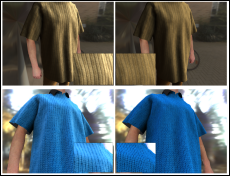
|
Realistic Visualization of Animated Virtual Cloth M. Sattler [Thesispage] |
| 2005 | |
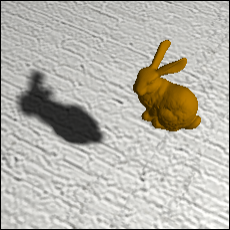
|
Exploitation of human shadow perception for fast shadow rendering M. Sattler, R. Sarlette, T. Mücken, R. Klein Proceedings of the ACM SIGGRAPH Symposium on Applied Perception in Graphics and Visualization (APGV 2005) August 2005, pages 131-134 [Paper] [BibTeX] In this paper we describe an experiment to obtain information about the perceptual potential of the human visual system regarding shadow perception. Shadows play an important part for communicating spatial structures of objects to the observer. They are also essential for the overall realism of the rendered image. Unfortunately, most algorithms in computer graphics which are capable of producing realistic shadows are computationally expensive. The main idea behind the experiment is to use a simplified version of the shadow caster to generate hard and soft shadows, which would rapidly increase performance and to evaluate up to which degree a simplification is possible, without producing noticeable errors. Therefore, an experiment is performed, in which the test persons should mark the point of the just noticeable difference. First results show, that a mesh simplified to only 1% of its original complexity is capable to cast soft shadows that satisfy 90% of the test persons. |
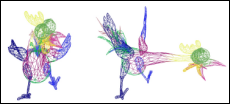
|
Simple and efficient compression of animation sequences M. Sattler, R. Sarlette, R. Klein Proceedings of the 2005 ACM SIGGRAPH/Eurographics symposium on Computer animation (SCA 2005) July 2005, pages 209-217 [Paper] [BibTeX] [Video,15MB] We present a new geometry compression method for animations, which is based on the clustered principal component analysis (CPCA). Instead of analyzing the set of vertices for each frame, our method analyzes the set of paths for all vertices for a certain animation length. Thus, using a data-driven approach, it can identify mesh parts, that are "coherent" over time. This usually leads to a very efficient and robust segmentation of the mesh into meaningful clusters, e.g. the wings of a chicken. These parts are then compressed separately using standard principal component analysis (PCA). Each of this clusters can be compressed more efficiently with lesser PCA components compared to previous approaches. Results show, that the new method outperforms other compression schemes like pure PCA based compression or combinations with linear prediction coding, while maintaining a better reconstruction error. This is true, even if the components and weights are quantized before transmission. The reconstruction process is very simple and can be performed directly on the GPU. |

|
Simulation and Visualisation of Virtual Textiles for Virtual Try-On Wacker, M., Keckeisen, M., Kimmerle, S., S., Wolfgang, Luckas, V., Groß;, V. , Fuhrmann ,A., Sattler, M., Sarlette R., Klein, R. Special Issue of Research Journal of Textile and Apparel: Virtual Clothing Technology and Applications, Vol. 9, No. 1 [Link] [BibTeX] The correct simulation and visualization of textiles comprises many research fields such as mathematics, physics, materials science, and computer graphics. It consists of modelling the physical behavior of textiles based on real data of garment patterns which have to be placed around an avatar. Therefore efficient numerical algorithms have to be developed to solve the appearing differential equations. Finally the obtained results are displayed photorealistically The aim of the national research project "Virtual Try-On" consists in providing a prototype of a virtual try-on scenario in a real shop or the internet realizing cost-effcient made-to-measure wear. In this article we present the whole process chain from the choice of clothes up to the final visualization and the individual evaluation of fit. |
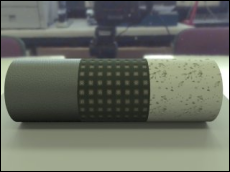
|
Acquisition, Synthesis and Rendering of Bidirectional Texture Functions G. Müller, J. Meseth, M. Sattler, R. Sarlette, R. Klein Computer Graphics forum, Vol. 24, No. 1 March 2005, pages 83-109 [Link] [BibTeX] One of the main challenges in computer graphics is still the realistic rendering of complex materials such as fabric or skin. The difficulty arises from the complex meso structure and reflectance behavior defining the unique look-and-feel of a material. A wide class of such realistic materials can be described as 2D-texture under varying light- and view direction namely the Bidirectional Texture Function (BTF). Since an easy and general method for modeling BTFs is not available, current research concentrates on image-based methods which rely on measured BTFs (acquired real-world data) in combination with appropriate synthesis methods. Recent results have shown that this approach greatly improves the visual quality of rendered surfaces and therefore the quality of applications such as virtual prototyping. This STAR will present in detail the state-of-the-art techniques for the main tasks involved in producing photo-realistic renderings using measured BTFs. |
| 2004 | |
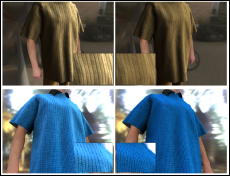
|
Virtual Try-On - Virtuelle Textilien in der Graphischen Datenverarbeitung Wacker, M., Keckeisen, M., Kimmerle, S., S., Wolfgang, Luckas, V., Groß, V. , Fuhrmann ,A., Sattler, M., Sarlette R., Klein, R. Informatik Spektrum, Vol. 27, No. 6 December 2004, pages 504-511 [Link] [BibTeX] Durch die beschriebenen Verfahren und die Verwendung realer Eingabedaten, von CAD-Schnittteilen über physikalische Materialparameter bis hin zu gemessenen BTFs, gelingt eine realistische Darstellung von Textilien. Die im Virtual-Try-On Projekt entwickelten Techniken sollen es in naher Zukunft ermöglichen,Maßkonfektion „on demand" herzustellen, die dem jeweiligen Kunden exakt passt. |
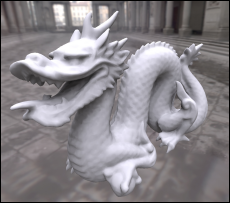
|
Hardware-accelerated ambient occlusion computation M. Sattler, R. Sarlette, G. Zachmann, R. Klein Proceedings of Vision, Modeling and Visualization 2004 (VMV 2004) November 2004, pages 331-338 [Paper] [BibTeX] [Video] In this paper, we present a novel, hardwareaccelerated approach to compute the visibility between surface points and directional light sources. Thus, our method provides a first-order approximation of the rendering equation in graphics hardware. This is done by accumulating depth tests of vertex fragments as seen from a number of light directions. Our method does not need any preprocessing of the scene elements and introduces no memory overhead. Besides of the handling of large polygonal models, it is suitable for deformable or animated objects under time-varying high-dynamic range illumination at interactive frame rates. |
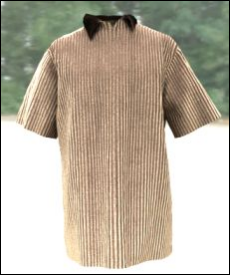
|
Acquisition, Synthesis and Rendering of Bidirectional Texture Functions G. Müller, J. Meseth, M. Sattler, R. Sarlette, R. Klein Proceedings of Eurographics 2004, State of the Art Reports (EG 2004) September 2004, pages 69-94 [Paper] [BibTeX] [Slides] [Video,33MB] One of the main challenges in computer graphics is still the realistic rendering of complex materials such as fabric or skin. The difficulty arises from the complex meso structure and reflectance behavior defining the unique look-and-feel of a material. A wide class of such realistic materials can be described as 2D-texture under varying light- and view direction namely the Bidirectional Texture Function (BTF). Since an easy and general method for modeling BTFs is not available, current research concentrates on image-based methods which rely on measured BTFs (acquired real-world data) in combination with appropriate synthesis methods. Recent results have shown that this approach greatly improves the visual quality of rendered surfaces and therefore the quality of applications such as virtual prototyping. This STAR will present in detail the state-of-the-art techniques for the main tasks involved in producing photo-realistic renderings using measured BTFs. |
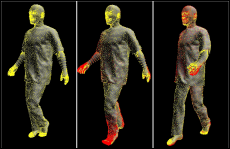
|
Probabilistic Motion Sequence Generation M. Sattler, R. Sarlette, R. Klein Proceedings of Computer Graphics International 2004 (CGI 2004) June 2004, pages 514-517 [Paper] [BibTeX] Creating long animation sequences with non-trivial repetitions is a time consuming and often difficult task. This is true for 2D images and even more true for 3D sequences. Based upon the idea of video textures we propose a simple algorithm to create new user controlled animation sequences based only on a few key frames by the analysis of velocity and position coherence. The simplicity of the method is achieved by carrying out the calculations on the main principal components of the reference animation, hence reducing the dimensionality of the input data. This also leads to significant compression. Smooth animations are ensured, using one of the two proposed blending schemes. The method is demonstrated with several examples. |
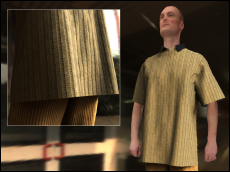
|
High Quality Rendering of Reflectance Data J. Meseth, G. Müller, M. Sattler, R. Sarlette, A. Artusi, A. Wilkie, G. Zotti, R. Klein, W. Purgathofer Proceedings of Computer Graphics International 2004, Tutorial (CGI 2004) June 2004 [BibTeX] Photorealistic graphics play a very important role in various application areas and industries, among them the computer game industry, movie production industry, and even traditional engineering which more and more employs VR applications for virtual prototyping and especially styling reviews. Since correct reflectance properties tremendously increase the realism of such applications, extending existing systems from these application areas immediately improves the overall product. The tutorial introduces the basic terminology, shows techniques for acquisition of reflectance properties of both synthetic and real-world materials, presents common representations for reflectance properties and elaborates on rendering techniques both for real-time and offline applications. While the tutorial gives an overview over existing techniques for most aspects, selected topics are described in much more detail. In addition to describing acquisition, storage and rendering of reflectance properties, related areas will be covered: texturing and parameterization, texture- and BTF synthesis and tone mapping represent techniques. These are inevitable to achieve really photorealistic results and are therefore required by every system that aims at using reflectance properties. Here, as well, an overview over the research areas is given, existing techniques are described and selected topics are elaborated on in more detail. |
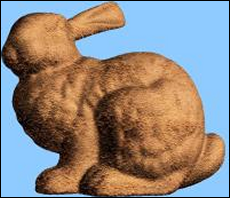
|
Decoupling BRDFs from Surface Mesostructures J. Kautz, M. Sattler, R. Sarlette, R. Klein, H.-P. Seidel Proceedings Graphics Interface 2004 May 2004, pages 177-184 [Paper] [BibTeX] [Video,4MB] We present a technique for the easy acquisition of realistic materials and mesostructures, without acquiring the actual BRDF. The method uses the observation that under certain circumstances the mesostructure of a surface can be acquired independently of the underlying BRDF. The acquired data can be used directly for rendering with little preprocessing. Rendering is possible using an offline renderer but also using graphics hardware, where it achieves real-time frame rates. Compelling results are achieved for a wide variety of materials. |
| 2003 | |
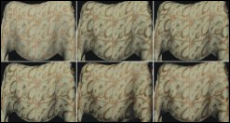
|
BTF Rendering for Virtual Environments J. Meseth, G. Müller, M. Sattler, R. Klein Proceedings of Virtual Concepts 2003 (VC 2003) November 2003, pages 356-363 [Paper] [BibTeX] Virtual Environments mostly try to convey as realistic as possible impressions. Among other senses, the eye provides the users with the most important inputs. Achieving visual realism typically relies on highly accurate geometric models. Unfortunately unhandleable amounts of triangles need to be rendered to adequately represent mesostructure. Furthermore, sophisticated lighting calculations need to be computed to incorporate local self-shadowing and interreflection effects. In current VR systems material representations like textures and bump-maps are utilized to compensate the abovementioned problems. While these approximations yield sufficient results for very simple materials, they are insufficient for more ambitious applications like cloth visualization or interior design, which require highly realistic material representations like the bi-directional texture function (BTF). In this work, we compare several real-time BTF rendering methods concerning accuracy, runtime and memory requirements, and identify application areas for the different techniques. In addition, we show how BTF rendering can be integrated into scene-graph systems. |
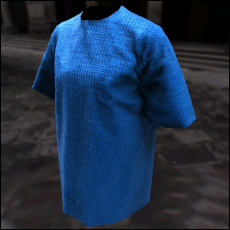
|
Efficient and Realistic Visualization of Cloth M. Sattler, R. Sarlette, R. Klein Proceedings of Eurographics Symposium on Rendering 2003 (EGSR 2003) June 2003, pages 167-177 [Paper] [BibTeX] [Video,52MB] Efficient and realistic rendering of cloth is of great interest especially in the context of e-commerce. Aside from the simulation of cloth draping, the rendering has to provide the "look and feel" of the fabric itself. In this paper we present a novel interactive rendering algorithm to preserve this "look and feel" of different fabrics. This is done by using the bidirectional texture function (BTF) of the fabric, which is acquired from a rectangular probe and after synthesis, mapped onto the simulated geometry. Instead of fitting a special type of bidirectional reflection distribution function (BRDF) model to each texel of our BTF, we generate view-dependent texture-maps using a principal component analysis of the original data. These view-dependent texture maps are then illuminated and rendered using either point-light sources or high dynamic range environment maps by exploiting current graphics hardware. In both cases, self-shadowing caused by geometry is taken into account. For point light sources, we also present a novel method to generate smooth shadow boundaries on the geometry. Depending on the geometrical complexity and the sampling density of the environment map, the illumination can be changed interactively. To ensure interactive frame rates for denser samplings or more complex objects, we introduce a principal component based decomposition of the illumination of the geometry. The high quality of the results is demonstrated by several examples. The algorithm is also suitable for materials other than cloth, as far as these materials have a similar reflectance behavior. |
| 2002 | |

|
Cloth Animation and Rendering M. Sattler, R. Sarlette, R. Klein Proceedings of Eurographics 2002, Tutorials (EG 2002) September 2002 [Paper] [BibTeX] The area of physically-based modeling is situated in the intersection of computer science, mathematics, and physics. The animation of cloth is a particularly interesting application of physically-based modeling, because it aims at fast animation solutions for rather difficult physical problems. Moreover, it addresses one of the major difficulties in creating realistic scenes with virtual actors. The challenge of computer animation is to break down physical models for complex structures as textiles, approximate them efficiently, and run fast simulations with intelligent numerical methods. Furthermore, interactivity and collisions with other objects in the scene are challenges that have motivated much creative work over the recent years. The range of methods proposed in literature is quite large. The techniques vary from simplified methods designed for real-time applications to sophisticated methods that were designed to reproduce measured material properties. Rendering cloth is especially difficult because of its complex material properties. Software rendering can deal with these properties fairly easily, once they have been acquired, but remains too slow for interactive applications. Hardware accelerated rendering often provides a way to achieve interactive renderings, unfortunately complex materials aren't directly supported. We will demonstrate how interactive rendering with complex materials can nonetheless be achieved. |
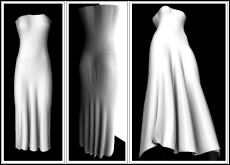
|
Realtime Shading of Folded Surfaces B.Ganster R. Klein M. Sattler R. Sarlette Advances in Modelling, Animation and Rendering (CGI 2002) July 2002, pages 465-480 [Paper] [BibTeX] In this paper we present a new, simple, and efficient way to illuminate folded surfaces with extended light sources in realtime including shadows. In a preprocessing step we compute the parts of the surrounding environment that are visible from a set of points on the surface and represent this information in a binary visibility map. The illumination of the scene, i.e., incoming light from different directions, is encoded in an environment map. This way, extended light sources and complex illumination conditions of the surface can be simulated. The binary visibility information stored in the visibility maps is used during runtime to calculate the incoming and outgoing radiance in the direction of the viewer for each sample point. Various reflection models like the Phong or Lafortune model can be incorporated into these calculations. After computing the radiance values in each sample point, the surface is shaded using simple Gouraud interpolation. Using the pre-computed visibility information, the whole shading and even the change of lighting conditions can be simulated in realtime by modifying the environment map. As an extension to the environment map we support additional point light sources whose parameters and positions can also be manipulated in realtime. Several examples of mesh illumination and shading are demonstrated. |
| 2001 | |
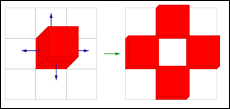
|
Erdbeben und zelluläre Automaten Untersuchung statistischer Eigenschaften M. Sattler Diploma Thesis, Institute of Geophysics, University Kiel April 2001 [BibTeX] By means of cellular automata (CA) earthquakes were simulated and their statistical characteristics were analysed. Forestfire and Sliderblockmodels are examined. Special attention was paid to the Sandpilemodel. The automata models produce an event distribution following a power-law relation and are partially in a state of organized criticality (SOC). This and further analogies (threshold values, stress increase) let a simulation of earthquakes with the automata appear justified. The basic model of the Sandpiles of Bak et al. (1987; 1988) was extended by some processes such as transient creeping, fractal threshold value distributions and new rearrangement algorithms. Event size distributions, event places, b-value-changes and modifications in the fractal dimension of the resulting machine states were examined. That b-value is an important variable in the Gutenberg-Richter-Relation, which links Magnitude and the number of quakes in an area. Also the loading phase of the machine under different conditions was observed and a procedure to differentiate these from the critical phase (SOC status) was developed in the beginning. The use of a fractal threshold value distribution did not result in significantly di erent results in relation to the conventional constant distribution. The b-value dependency on the dissipation parameter Α could be reproduced. The number of events increases with rising Α. This can be explained with a higher interaction at a distance of an individual event. With a zero-starting configuration clearly a subcritical (load-) phase and a critical area (SOC status) can be di erentiated. By means of an introduced parameter CM (cumulative seismicity) and b-value modifications these two phases can be separated, too. Additionally, a change in the fractal dimension of the spatial epicenter distribution could be observed. The model reacts temporarily sensitive to disturbances from the outside, which, depending on their size, can destroy the SOC behavior and result in further loading phases. These disturbances can also be read off consistently to the above results in the b-value. The spatial epicenter distribution shows a maximum with Α = 1.00, which disappears with smaller Α. Artificially produced weakness zones show themselves clearly, already during the load phase and do not influence the macroscopic behavior. They have, however, a small influence on the b-value and the total tension. The model extension with transient creeping does not show modifications apart from an increased tension level. During variations of the input distinguishable b-values can be determined. These come particularly with temporalily changing input to light. The spatially constant input produces di erent load curves, which show no clear level with Α < 1. The Sandpilemodell is only conditionally suitable for the modelling of real earthquakes, since important processes are missing, as for example, aftershocks. However the Sandpilemodell shows some statistical characteristics of earthquakes, since these are independent of details. |
| ;-) |